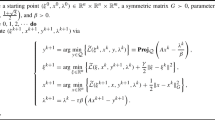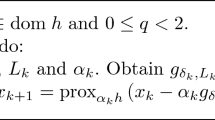Abstract
To solve a class of variational inequalities with separable structure, this paper presents a new method to improve the proximal alternating direction method (PADM) in the following senses: an iterate generated by the PADM is utilized to generate a descent direction; and an appropriate step size along this descent direction is identified. Hence, a descent-like method is developed. Convergence of the new method is proved under mild assumptions. Some numerical results demonstrate that the new method is efficient.
Similar content being viewed by others
References
Bertsekas, D.P., Tsitsiklis, J.N.: Parallel and Distributed Computation, Numerical Methods. Prentice-Hall, New York (1989)
Boyd, S., Vandenberghe, L.: Convex Optimization. Cambridge University Press, Cambridge (2004)
Chen, G., Teboulle, M.: A proximal-based decomposition method for convex minimization problem. Math. Program. 64, 81–101 (1994)
Dafermos, S.: Traffic equilibrium and variational inequalities. Transp. Sci. 4, 42–54 (1980)
Eaves, B.C.: On the basic theorem of complementarity. Math. Program. 1, 68–75 (1971)
Eckstein, J.: Some saddle-function splitting methods for convex programming. Optim. Methods Softw. 4, 75–83 (1994)
Eckstein, J., Bertsekas, D.P.: On the Douglas-Rachford splitting method and the proximal points algorithm for maximal monotone operators. Math. Program. 55, 293–318 (1992)
Eckstein, J., Fukushima, M.: Some reformulation and applications of the alternating direction method of multipliers. In: Hager, W.W., et al. (eds.) Large Scale Optimization: State of the Art, pp. 115–134. Kluwer Academic, Dordrecht (1994)
Fortin, M., Glowinski, R. (eds.): Augmented Lagrangian Methods: Applications to the solution of Boundary-Valued Problems. North-Holland, Amsterdam (1983)
Fukushima, M.: Application of the alternating direction method of multipliers to separable convex programming problems. Comput. Optim. Appl. 2, 93–111 (1992)
Gabay, D., Mercier, B.: A dual algorithm for the solution of nonlinear variational problems via finite-element approximations. Comput. Math. Appl. 2, 17–40 (1976)
Gabay, D.: Applications of the method of multipliers to variational inequalities. In: Fortin, M., Glowinski, R. (eds.) Augmented Lagrange Methods: Applications to the Solution of Boundary-valued Problems, pp. 299–331. North Holland, Amsterdam (1983)
Gao, Y., Sun, D.F.: Calibrating least square covariance matrix problems with equality and inequality constraints. Manuscript, available on http://www.math.nus.edu.sg/~matsundf/
Glowinski, R.: Numerical Methods for Nonlinear Variational Problems. Springer, New York, Berlin, Heidelberg, Tokyo (1984)
Glunt, W.: An alternating projections method for certain linear problems in a Hilbert space. IMA J. Numer. Anal. 15, 291–305 (1995)
Golub, G.H., Van Loan, C.F.: Matrix Computation. The Johns Hopkins Press, Baltimore (1996)
Güler, O.: New proximal point algorithms for convex minimization. SIAM J. Optim. 2(4), 649–664 (1992)
Hager, W.W., Zhang, H.C.: Self-adaptive inexact proximal point methods. Comput. Optim. Appl. 39(2), 161–181 (2008)
Hager, W.W., Zhang, H.C.: Asymptotic convergence analysis of a new class of proximal point methods. SIAM J. Control Optim. 46(5), 1683–1704 (2007)
Harker, P.T., Pang, J.S.: A damped–Newton method for the linear complementarity problem. Lect. Appl. Math. 26, 265–284 (1990)
He, B.S., Yang, H., Wang, S.L.: Alternating directions method with self-adaptive parameter for monotone variational inequalities. J. Optim. Theory Appl. 106, 349–368 (2000)
He, B.S., Liao, L.Z., Han, D.R., Yang, H.: A new inexact alternating directions method for monotone variational inequalities. Math. Program. 92, 103–118 (2002)
He, B.S., Yuan, X.M., Zhang, J.Z.: Comparison of two kinds of prediction-correction methods for monotone variational inequalities. Comput. Optim. Appl. 27(3), 247–267 (2004)
Khobotov, E.N.: Modification of the extragradient method for solving variational inequalities and certain optimization problems. USSR Comput. Math. Phys. 27, 120–127 (1987)
Kontogiorgis, S., Meyer, R.R.: A variable-penalty alternating directions method for convex optimization. Math. Program. 83, 29–53 (1998)
Martinet, B.: Regularization d’inequations variationelles par approximations sucessives. Rev. Fr. Inform. Rech. Opér. 4, 154–159 (1970)
Nagurney, A.: Network Economics, a Variational Inequality Approach. Kluwer Academic, Dordrecht (1993)
Rockafellar, R.T.: Monotone operators and the proximal point algorithm. SIAM J. Control Optim. 126, 877–898 (1976)
Rockafellar, R.T.: Augmented Lagrangians and applications of the proximal point algorithm in convex programming. Math. Oper. Res. 1, 97–116 (1976)
Solodov, M.V., Tseng, P.: Modified projection-type methods for monotone variational inequalities. SIAM J. Control Optim. 34, 1814–1830 (1996)
Sun, D.: A class of iterative methods for solving nonlinear projection equations. J. Optim. Theory Appl. 91, 123–140 (1996)
Taji, K., Fukushima, M., Ibaraki, T.: A globally convergent Newton method for solving strongly monotone variational inequalities. Math. Program. 58, 369–383 (1993)
Teboulle, M.: Convergence of proximal-like algorithms. SIAM J. Optim. 7, 1069–1083 (1997)
Tseng, P.: Applications of splitting algorithm to decomposition in convex programming and variational inequalities. SIAM J. Control Optim. 29, 119–138 (1991)
Tseng, P.: Alternating projection-proximal methods for convex programming and variational inequalities. SIAM J. Optim. 7, 951–965 (1997)
Ye, C.H., Yuan, X.M.: A descent method for structured monotone variational inequalities. Optim. Methods Softw. 22(2), 329–338 (2007)
Author information
Authors and Affiliations
Corresponding author
Additional information
This author was supported in part by the RGC Grant 203009 and the NSFC grant 10701055.
Rights and permissions
About this article
Cite this article
Yuan, X. An improved proximal alternating direction method for monotone variational inequalities with separable structure. Comput Optim Appl 49, 17–29 (2011). https://doi.org/10.1007/s10589-009-9293-y
Received:
Published:
Issue Date:
DOI: https://doi.org/10.1007/s10589-009-9293-y




